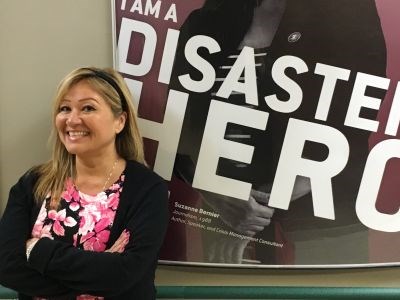Fireweed blooms in areas damaged by a forest fire, the tall pink flowers bright against the destruction. Suzanne Bernier works like the fireweed: where disasters happen, she pops up. And like the flower, the disaster management consultant brings some beauty back into a damaged landscape.
In her new book, “Disaster Heroes – Invisible Champions of Help, Hope and Healing,” Bernier writes from her experiences, and celebrates the heroes who emerge from a disaster.
“I wanted to try and highlight the positive sides of disasters,” said Bernier. “You rarely hear about the positive side in the news and the media, the good things happening, the good people who come together every time there's a disaster.”
Bernier will be talking about her book at the Idylwylde Gold & Country Club in Sudbury on June 24. Partial proceeds of the talk will go towards the Alberta Chamber of Commerce fund for the Fort McMurray and Wood Buffalo Region Business Community following the spring fires.
Bernier's book celebrates the people she's worked with around the world, but she started her journey right here in Northern Ontario.
Bernier was born in Toronto and spent her childhood in North Bay. High school was a positive experience where Bernier realized she had a passion for people and communicating, and she took up MCing school events. When she graduated as valedictorian, they created a bursary specifically for Bernier to be able to go to Cambrian College in Sudbury and pursue a diploma in journalism.
“It was a real push for them to say we believe in you,” said Bernier, who started at the early age of 17 and graduated at 19.
After graduating, Bernier worked as a journalist in Sudbury for a couple years before moving to Toronto in 1991 to take up communications for the provincial government. After a year and a half, Bernier shifted to doing communications for the Ontario public safety division, and she found herself inspired by the work of Emergency Management Ontario (EMO).
“Once I started, I realized the amazing work the EMO was doing and their officers were doing,” said Bernier. “I didn't want to be a spokesperson talking about what they were doing, I wanted to be an officer and do those things.”
When a position for an officer opened up in 1997, she went for it, but not without some difficulty.
“They didn't want to give me the position because they didn't want to give it to a female. Back then I had to fight for it; it was a safety thing in their minds,” said Bernier. “I argued that, well, the other officers are going in alone, and if something's unsafe for me, it's just as unsafe for the 45-year-old man. I argued enough that I got the position, and I designed the first official uniform skirt!”
Bernier spent the next five years as the Northeastern Ontario field officer for EMO, based out of Sudbury. She faced her first disaster with the 1998 ice storm.
“We were hit really hard, too. The focus was on Montreal, but in Ontario alone, 66 communities declared an emergency and we only had four officers,” said Bernier. “I was thrown right into what it means to be in a huge disaster area like that.”
Much of Bernier's time was spent on fires and floods in remote communities, and between disasters, she forged relationships and strategies with people in the communities, and found some of her first disaster heroes. She also learned important strategies from the communities she was helping.
“My experiences in Northern Ontario were incredible. Working with communities in Northern Ontario, from fire chief to police chief to mayors, they were one of the most receptive areas of the province to recognize the need to be prepared for an emergency.”
Today, Bernier applies these strategies to disasters around the world. She's done work on 9/11, Hurricane Katrina, the Brussels attacks in Belgium, and Fort McMurray, and anticipates she will be heading to Kumamoto, Japan over the summer to do follow up on the earthquakes that happened in April.
Bernier hopes her experiences and her book can bring a degree of hope and inspire people in communities facing a disaster.
“We can't prevent disasters from happening but what we can change is our outlook, perspective and what we see when these disasters happen,” said Bernier.




